Costing Methods
VerifiedAdded on 2023/03/23
|8
|1594
|87
AI Summary
This document discusses various costing methods and their benefits. It covers topics such as cost control, wastage reduction, measuring performance, and activity-based costing. The document also provides recommendations for different scenarios and industries.
Contribute Materials
Your contribution can guide someone’s learning journey. Share your
documents today.
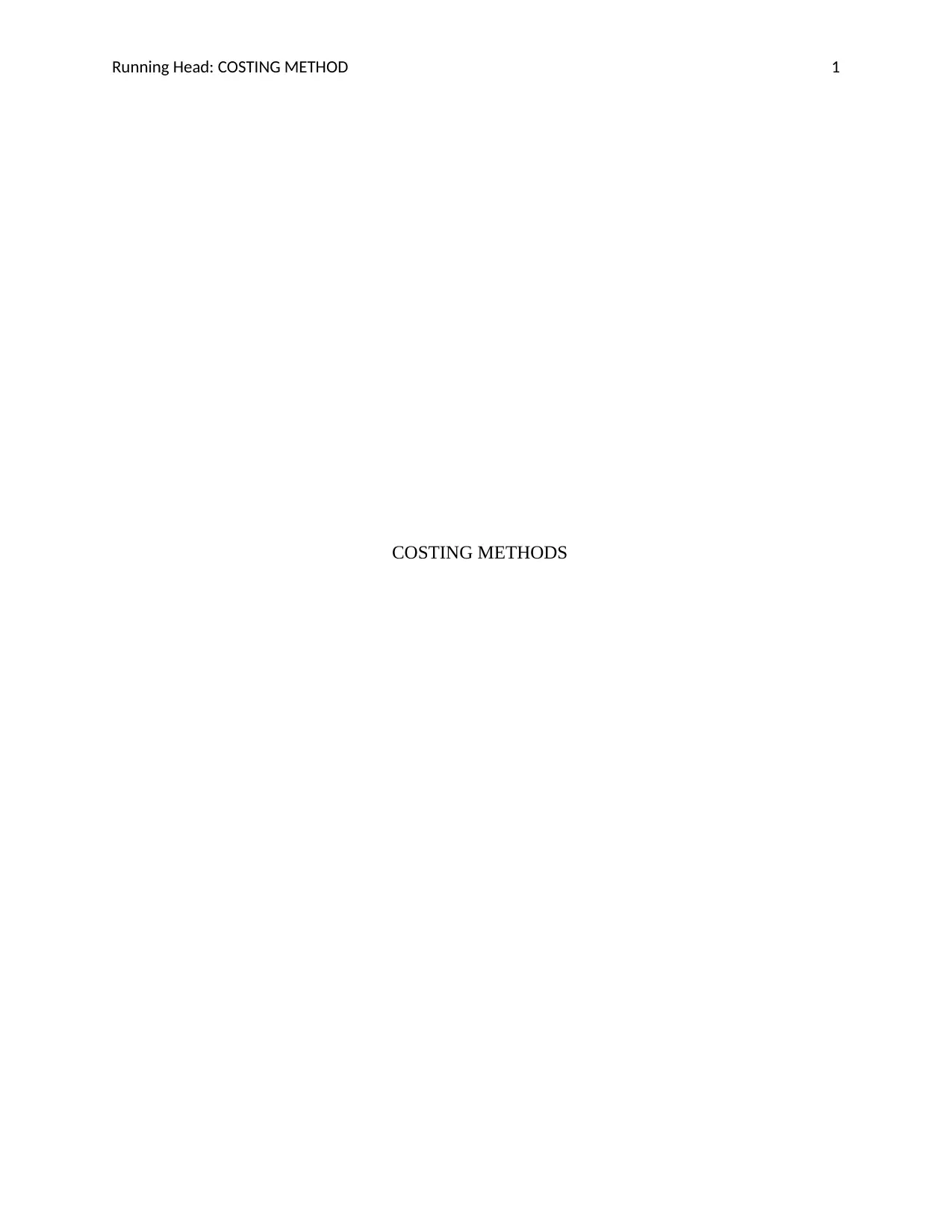
Running Head: COSTING METHOD 1
COSTING METHODS
COSTING METHODS
Secure Best Marks with AI Grader
Need help grading? Try our AI Grader for instant feedback on your assignments.
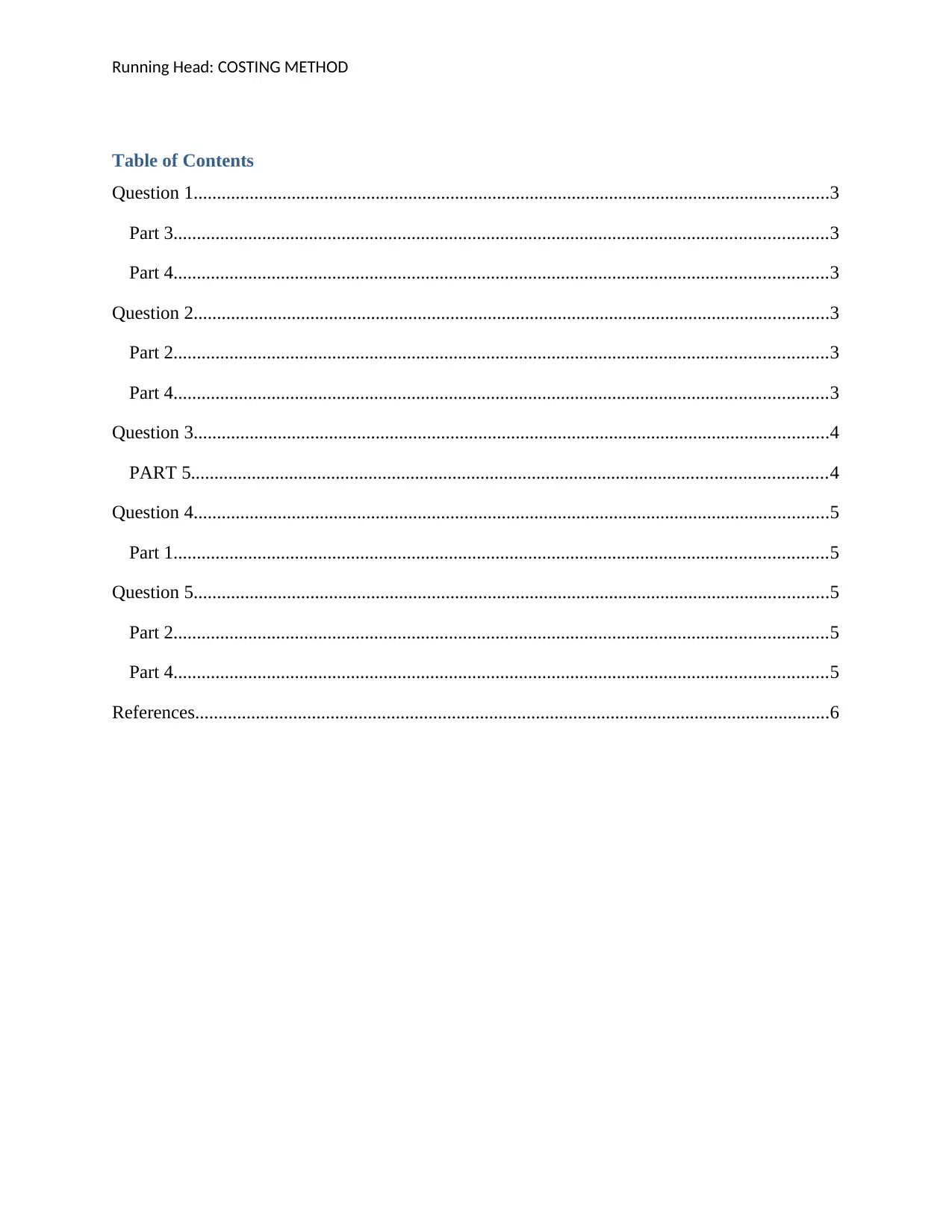
Running Head: COSTING METHOD
Table of Contents
Question 1........................................................................................................................................3
Part 3............................................................................................................................................3
Part 4............................................................................................................................................3
Question 2........................................................................................................................................3
Part 2............................................................................................................................................3
Part 4............................................................................................................................................3
Question 3........................................................................................................................................4
PART 5........................................................................................................................................4
Question 4........................................................................................................................................5
Part 1............................................................................................................................................5
Question 5........................................................................................................................................5
Part 2............................................................................................................................................5
Part 4............................................................................................................................................5
References........................................................................................................................................6
Table of Contents
Question 1........................................................................................................................................3
Part 3............................................................................................................................................3
Part 4............................................................................................................................................3
Question 2........................................................................................................................................3
Part 2............................................................................................................................................3
Part 4............................................................................................................................................3
Question 3........................................................................................................................................4
PART 5........................................................................................................................................4
Question 4........................................................................................................................................5
Part 1............................................................................................................................................5
Question 5........................................................................................................................................5
Part 2............................................................................................................................................5
Part 4............................................................................................................................................5
References........................................................................................................................................6
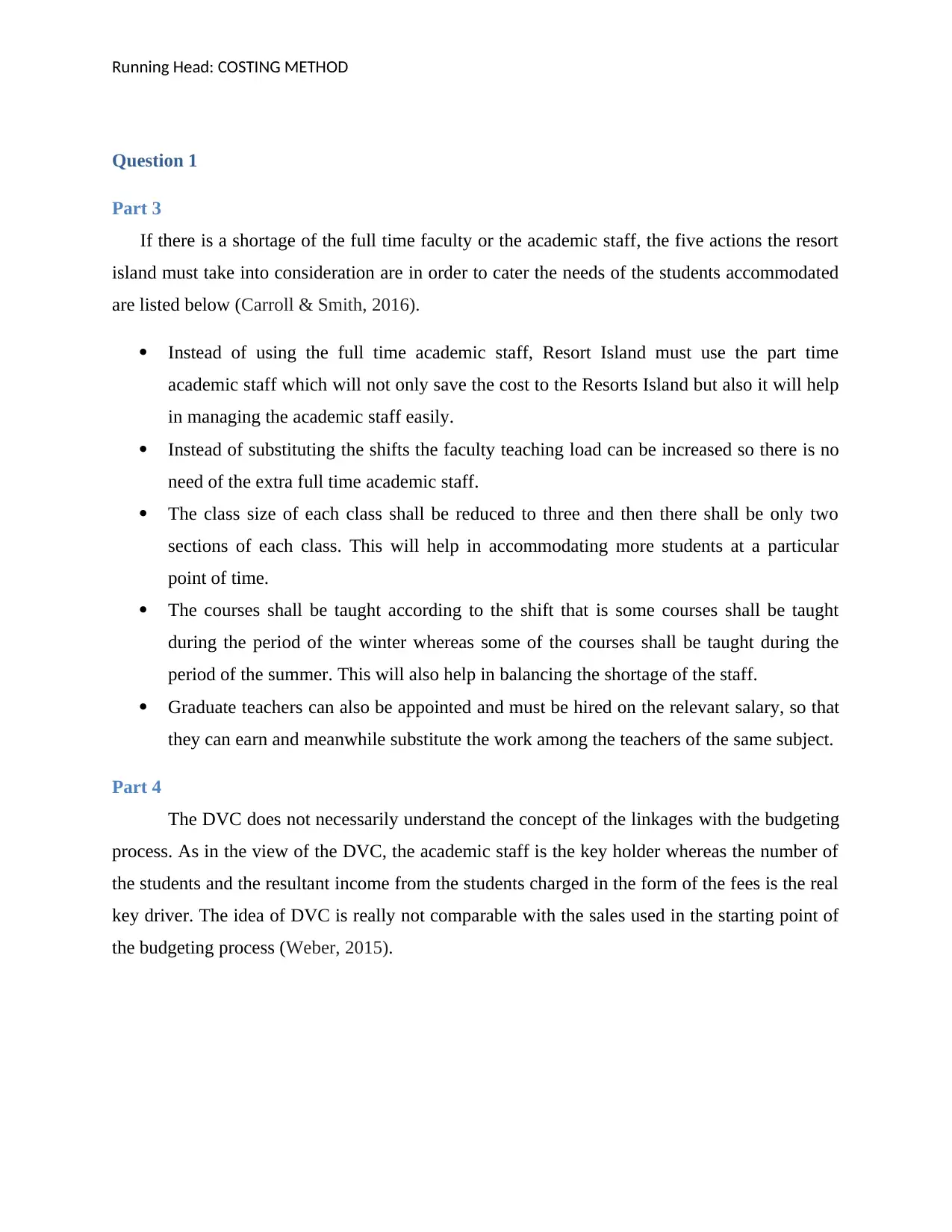
Running Head: COSTING METHOD
Question 1
Part 3
If there is a shortage of the full time faculty or the academic staff, the five actions the resort
island must take into consideration are in order to cater the needs of the students accommodated
are listed below (Carroll & Smith, 2016).
Instead of using the full time academic staff, Resort Island must use the part time
academic staff which will not only save the cost to the Resorts Island but also it will help
in managing the academic staff easily.
Instead of substituting the shifts the faculty teaching load can be increased so there is no
need of the extra full time academic staff.
The class size of each class shall be reduced to three and then there shall be only two
sections of each class. This will help in accommodating more students at a particular
point of time.
The courses shall be taught according to the shift that is some courses shall be taught
during the period of the winter whereas some of the courses shall be taught during the
period of the summer. This will also help in balancing the shortage of the staff.
Graduate teachers can also be appointed and must be hired on the relevant salary, so that
they can earn and meanwhile substitute the work among the teachers of the same subject.
Part 4
The DVC does not necessarily understand the concept of the linkages with the budgeting
process. As in the view of the DVC, the academic staff is the key holder whereas the number of
the students and the resultant income from the students charged in the form of the fees is the real
key driver. The idea of DVC is really not comparable with the sales used in the starting point of
the budgeting process (Weber, 2015).
Question 1
Part 3
If there is a shortage of the full time faculty or the academic staff, the five actions the resort
island must take into consideration are in order to cater the needs of the students accommodated
are listed below (Carroll & Smith, 2016).
Instead of using the full time academic staff, Resort Island must use the part time
academic staff which will not only save the cost to the Resorts Island but also it will help
in managing the academic staff easily.
Instead of substituting the shifts the faculty teaching load can be increased so there is no
need of the extra full time academic staff.
The class size of each class shall be reduced to three and then there shall be only two
sections of each class. This will help in accommodating more students at a particular
point of time.
The courses shall be taught according to the shift that is some courses shall be taught
during the period of the winter whereas some of the courses shall be taught during the
period of the summer. This will also help in balancing the shortage of the staff.
Graduate teachers can also be appointed and must be hired on the relevant salary, so that
they can earn and meanwhile substitute the work among the teachers of the same subject.
Part 4
The DVC does not necessarily understand the concept of the linkages with the budgeting
process. As in the view of the DVC, the academic staff is the key holder whereas the number of
the students and the resultant income from the students charged in the form of the fees is the real
key driver. The idea of DVC is really not comparable with the sales used in the starting point of
the budgeting process (Weber, 2015).
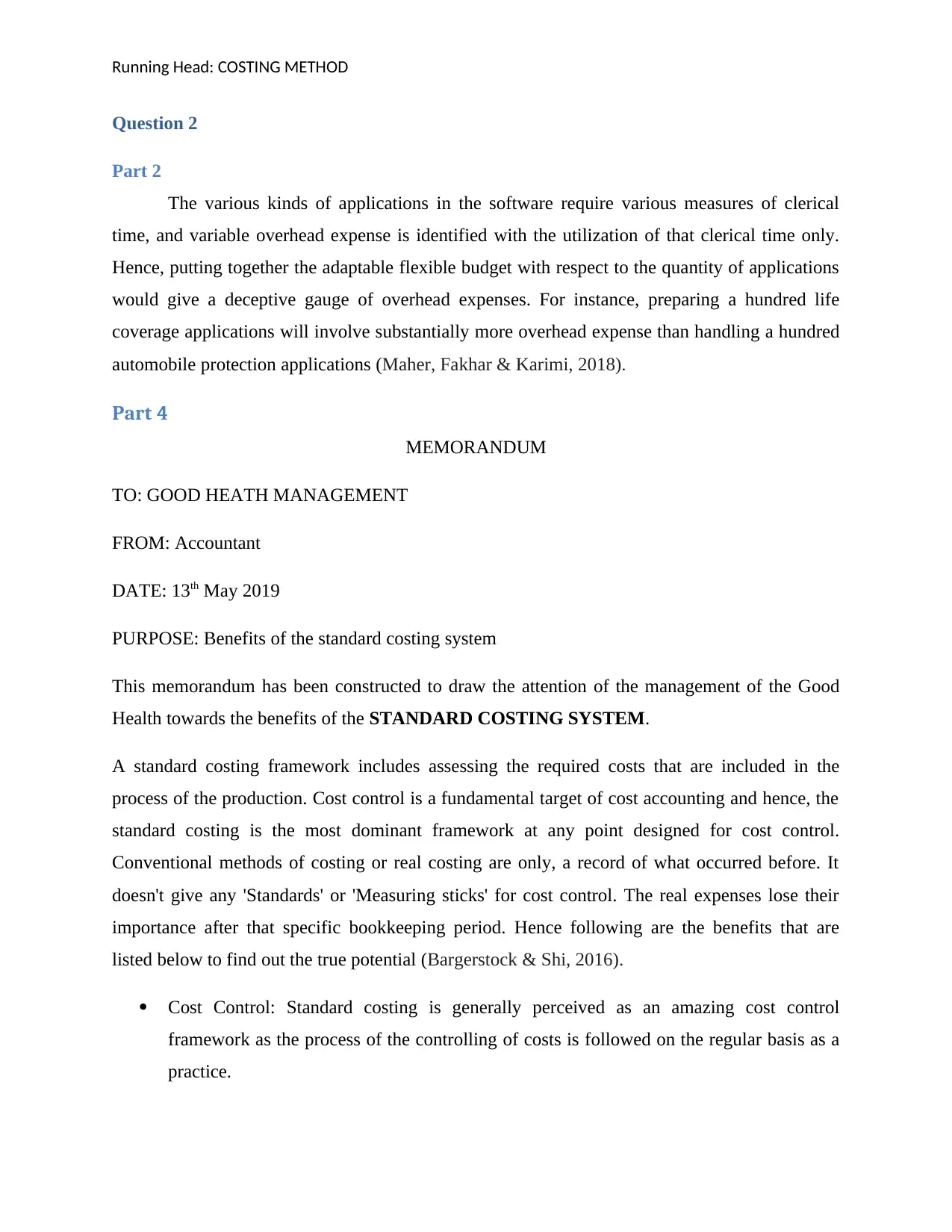
Running Head: COSTING METHOD
Question 2
Part 2
The various kinds of applications in the software require various measures of clerical
time, and variable overhead expense is identified with the utilization of that clerical time only.
Hence, putting together the adaptable flexible budget with respect to the quantity of applications
would give a deceptive gauge of overhead expenses. For instance, preparing a hundred life
coverage applications will involve substantially more overhead expense than handling a hundred
automobile protection applications (Maher, Fakhar & Karimi, 2018).
Part 4
MEMORANDUM
TO: GOOD HEATH MANAGEMENT
FROM: Accountant
DATE: 13th May 2019
PURPOSE: Benefits of the standard costing system
This memorandum has been constructed to draw the attention of the management of the Good
Health towards the benefits of the STANDARD COSTING SYSTEM.
A standard costing framework includes assessing the required costs that are included in the
process of the production. Cost control is a fundamental target of cost accounting and hence, the
standard costing is the most dominant framework at any point designed for cost control.
Conventional methods of costing or real costing are only, a record of what occurred before. It
doesn't give any 'Standards' or 'Measuring sticks' for cost control. The real expenses lose their
importance after that specific bookkeeping period. Hence following are the benefits that are
listed below to find out the true potential (Bargerstock & Shi, 2016).
Cost Control: Standard costing is generally perceived as an amazing cost control
framework as the process of the controlling of costs is followed on the regular basis as a
practice.
Question 2
Part 2
The various kinds of applications in the software require various measures of clerical
time, and variable overhead expense is identified with the utilization of that clerical time only.
Hence, putting together the adaptable flexible budget with respect to the quantity of applications
would give a deceptive gauge of overhead expenses. For instance, preparing a hundred life
coverage applications will involve substantially more overhead expense than handling a hundred
automobile protection applications (Maher, Fakhar & Karimi, 2018).
Part 4
MEMORANDUM
TO: GOOD HEATH MANAGEMENT
FROM: Accountant
DATE: 13th May 2019
PURPOSE: Benefits of the standard costing system
This memorandum has been constructed to draw the attention of the management of the Good
Health towards the benefits of the STANDARD COSTING SYSTEM.
A standard costing framework includes assessing the required costs that are included in the
process of the production. Cost control is a fundamental target of cost accounting and hence, the
standard costing is the most dominant framework at any point designed for cost control.
Conventional methods of costing or real costing are only, a record of what occurred before. It
doesn't give any 'Standards' or 'Measuring sticks' for cost control. The real expenses lose their
importance after that specific bookkeeping period. Hence following are the benefits that are
listed below to find out the true potential (Bargerstock & Shi, 2016).
Cost Control: Standard costing is generally perceived as an amazing cost control
framework as the process of the controlling of costs is followed on the regular basis as a
practice.
Secure Best Marks with AI Grader
Need help grading? Try our AI Grader for instant feedback on your assignments.
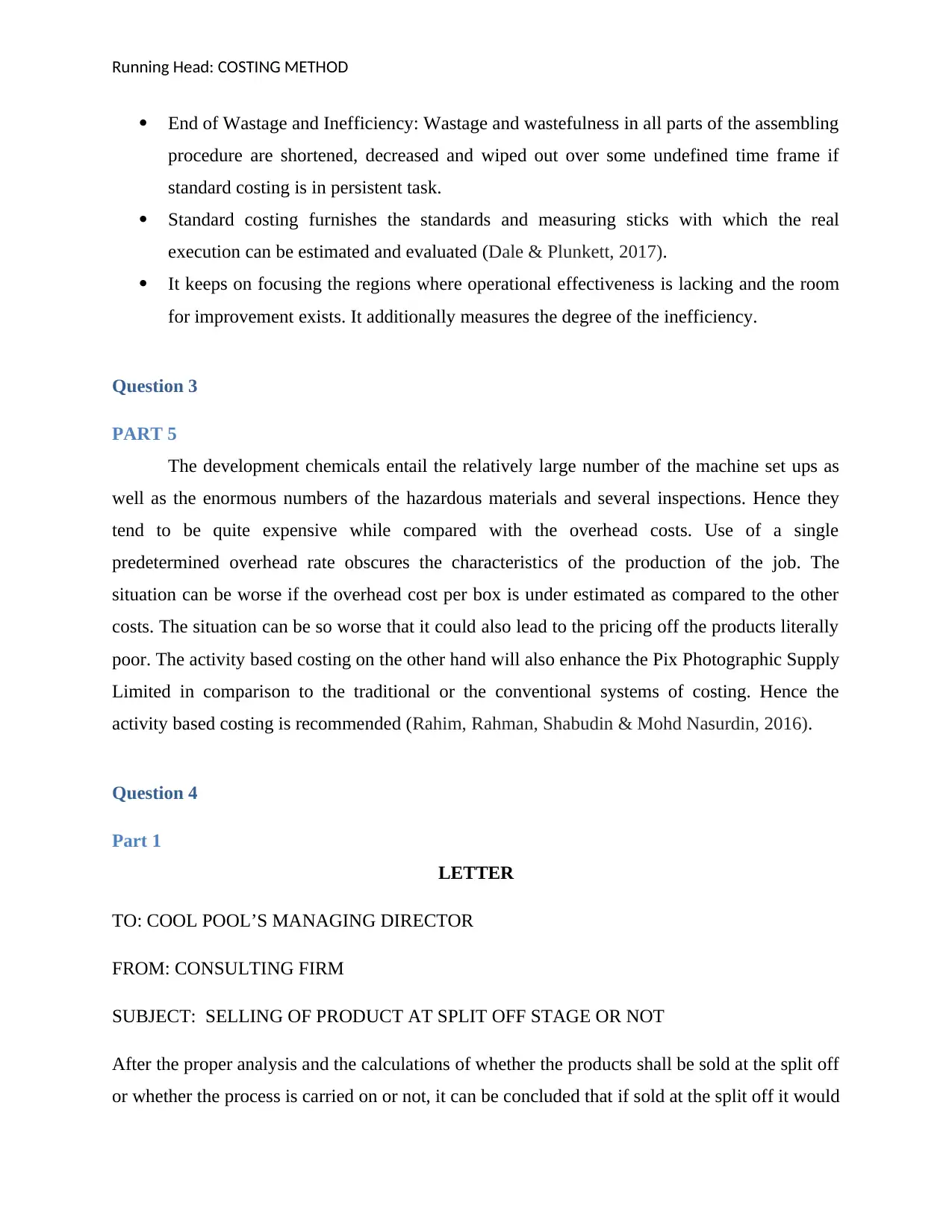
Running Head: COSTING METHOD
End of Wastage and Inefficiency: Wastage and wastefulness in all parts of the assembling
procedure are shortened, decreased and wiped out over some undefined time frame if
standard costing is in persistent task.
Standard costing furnishes the standards and measuring sticks with which the real
execution can be estimated and evaluated (Dale & Plunkett, 2017).
It keeps on focusing the regions where operational effectiveness is lacking and the room
for improvement exists. It additionally measures the degree of the inefficiency.
Question 3
PART 5
The development chemicals entail the relatively large number of the machine set ups as
well as the enormous numbers of the hazardous materials and several inspections. Hence they
tend to be quite expensive while compared with the overhead costs. Use of a single
predetermined overhead rate obscures the characteristics of the production of the job. The
situation can be worse if the overhead cost per box is under estimated as compared to the other
costs. The situation can be so worse that it could also lead to the pricing off the products literally
poor. The activity based costing on the other hand will also enhance the Pix Photographic Supply
Limited in comparison to the traditional or the conventional systems of costing. Hence the
activity based costing is recommended (Rahim, Rahman, Shabudin & Mohd Nasurdin, 2016).
Question 4
Part 1
LETTER
TO: COOL POOL’S MANAGING DIRECTOR
FROM: CONSULTING FIRM
SUBJECT: SELLING OF PRODUCT AT SPLIT OFF STAGE OR NOT
After the proper analysis and the calculations of whether the products shall be sold at the split off
or whether the process is carried on or not, it can be concluded that if sold at the split off it would
End of Wastage and Inefficiency: Wastage and wastefulness in all parts of the assembling
procedure are shortened, decreased and wiped out over some undefined time frame if
standard costing is in persistent task.
Standard costing furnishes the standards and measuring sticks with which the real
execution can be estimated and evaluated (Dale & Plunkett, 2017).
It keeps on focusing the regions where operational effectiveness is lacking and the room
for improvement exists. It additionally measures the degree of the inefficiency.
Question 3
PART 5
The development chemicals entail the relatively large number of the machine set ups as
well as the enormous numbers of the hazardous materials and several inspections. Hence they
tend to be quite expensive while compared with the overhead costs. Use of a single
predetermined overhead rate obscures the characteristics of the production of the job. The
situation can be worse if the overhead cost per box is under estimated as compared to the other
costs. The situation can be so worse that it could also lead to the pricing off the products literally
poor. The activity based costing on the other hand will also enhance the Pix Photographic Supply
Limited in comparison to the traditional or the conventional systems of costing. Hence the
activity based costing is recommended (Rahim, Rahman, Shabudin & Mohd Nasurdin, 2016).
Question 4
Part 1
LETTER
TO: COOL POOL’S MANAGING DIRECTOR
FROM: CONSULTING FIRM
SUBJECT: SELLING OF PRODUCT AT SPLIT OFF STAGE OR NOT
After the proper analysis and the calculations of whether the products shall be sold at the split off
or whether the process is carried on or not, it can be concluded that if sold at the split off it would
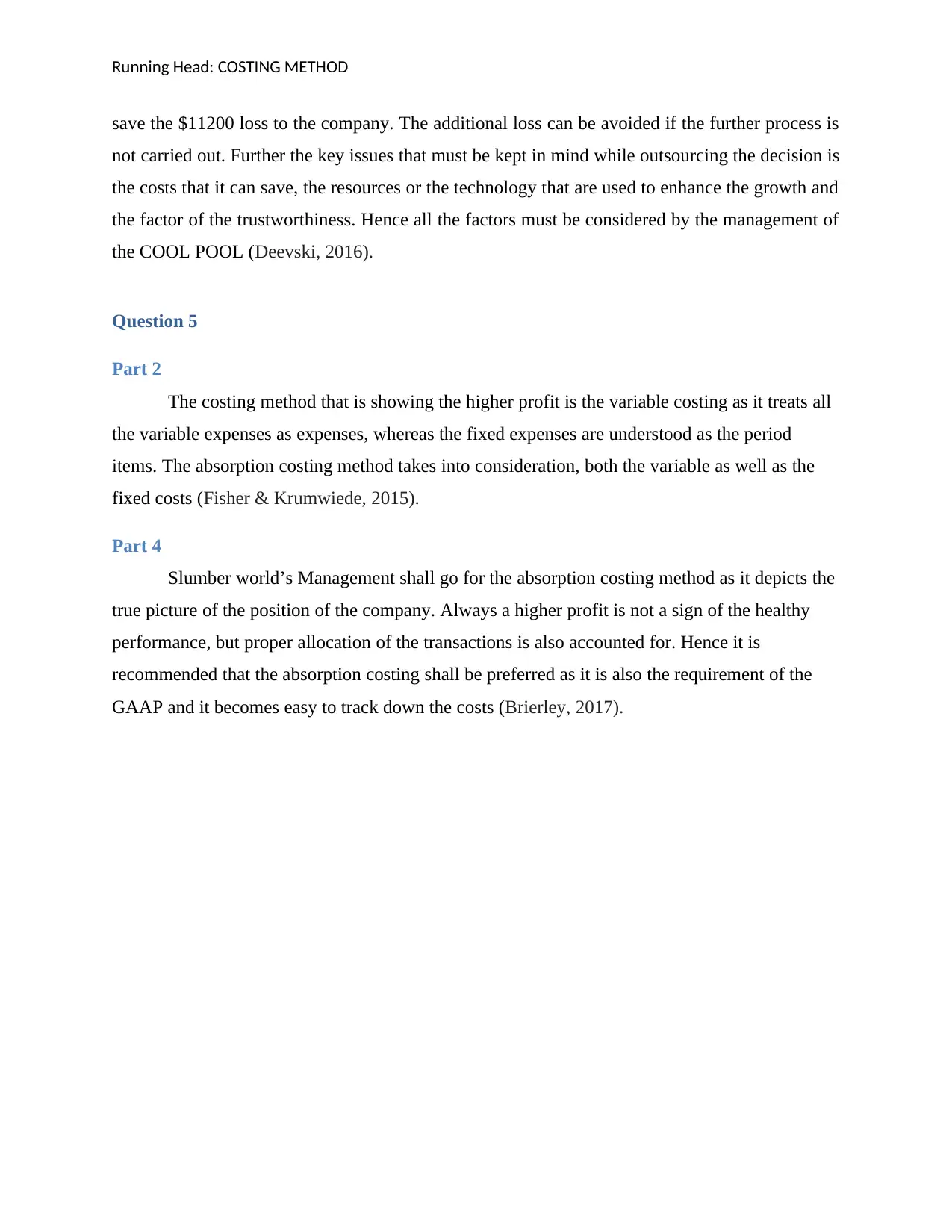
Running Head: COSTING METHOD
save the $11200 loss to the company. The additional loss can be avoided if the further process is
not carried out. Further the key issues that must be kept in mind while outsourcing the decision is
the costs that it can save, the resources or the technology that are used to enhance the growth and
the factor of the trustworthiness. Hence all the factors must be considered by the management of
the COOL POOL (Deevski, 2016).
Question 5
Part 2
The costing method that is showing the higher profit is the variable costing as it treats all
the variable expenses as expenses, whereas the fixed expenses are understood as the period
items. The absorption costing method takes into consideration, both the variable as well as the
fixed costs (Fisher & Krumwiede, 2015).
Part 4
Slumber world’s Management shall go for the absorption costing method as it depicts the
true picture of the position of the company. Always a higher profit is not a sign of the healthy
performance, but proper allocation of the transactions is also accounted for. Hence it is
recommended that the absorption costing shall be preferred as it is also the requirement of the
GAAP and it becomes easy to track down the costs (Brierley, 2017).
save the $11200 loss to the company. The additional loss can be avoided if the further process is
not carried out. Further the key issues that must be kept in mind while outsourcing the decision is
the costs that it can save, the resources or the technology that are used to enhance the growth and
the factor of the trustworthiness. Hence all the factors must be considered by the management of
the COOL POOL (Deevski, 2016).
Question 5
Part 2
The costing method that is showing the higher profit is the variable costing as it treats all
the variable expenses as expenses, whereas the fixed expenses are understood as the period
items. The absorption costing method takes into consideration, both the variable as well as the
fixed costs (Fisher & Krumwiede, 2015).
Part 4
Slumber world’s Management shall go for the absorption costing method as it depicts the
true picture of the position of the company. Always a higher profit is not a sign of the healthy
performance, but proper allocation of the transactions is also accounted for. Hence it is
recommended that the absorption costing shall be preferred as it is also the requirement of the
GAAP and it becomes easy to track down the costs (Brierley, 2017).
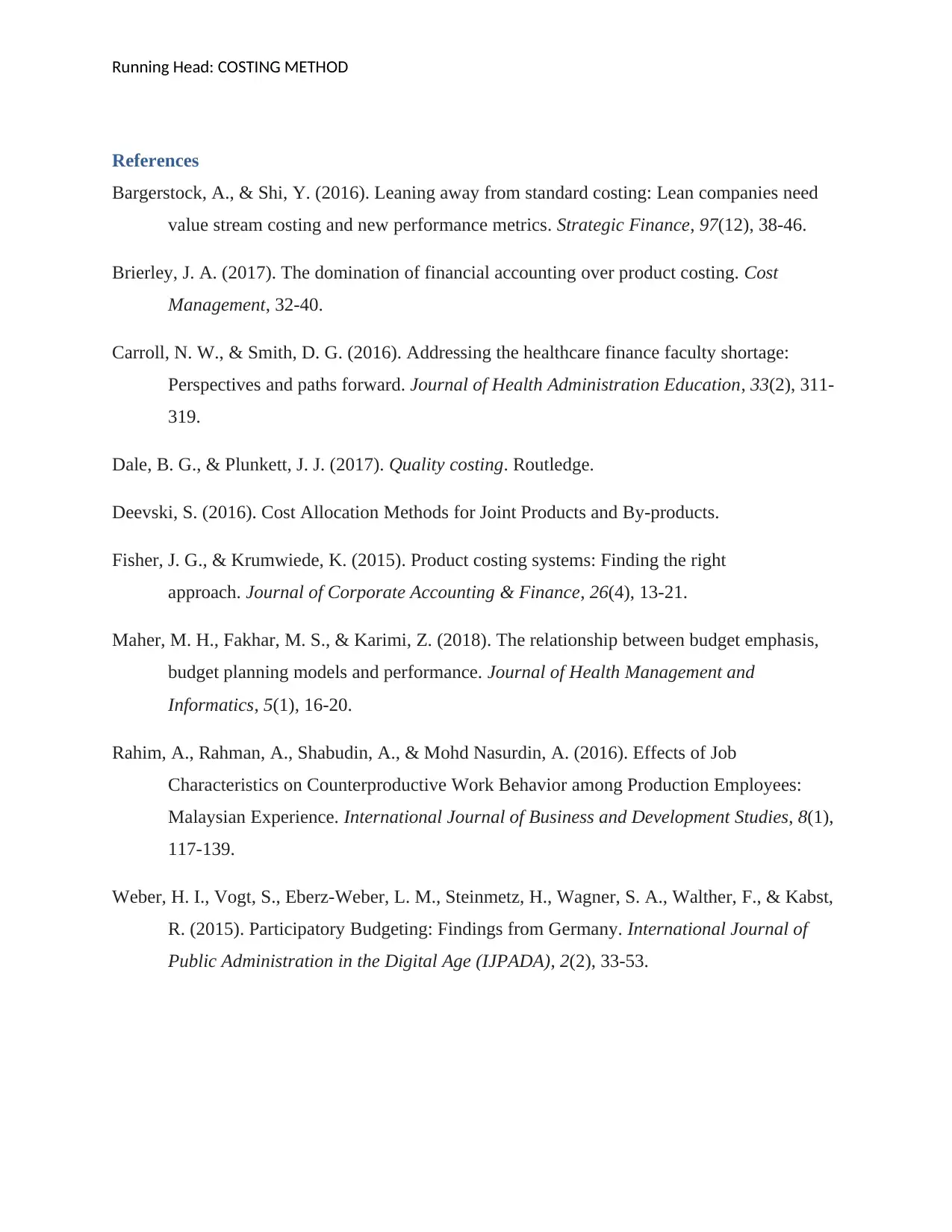
Running Head: COSTING METHOD
References
Bargerstock, A., & Shi, Y. (2016). Leaning away from standard costing: Lean companies need
value stream costing and new performance metrics. Strategic Finance, 97(12), 38-46.
Brierley, J. A. (2017). The domination of financial accounting over product costing. Cost
Management, 32-40.
Carroll, N. W., & Smith, D. G. (2016). Addressing the healthcare finance faculty shortage:
Perspectives and paths forward. Journal of Health Administration Education, 33(2), 311-
319.
Dale, B. G., & Plunkett, J. J. (2017). Quality costing. Routledge.
Deevski, S. (2016). Cost Allocation Мethods for Joint Products and By-products.
Fisher, J. G., & Krumwiede, K. (2015). Product costing systems: Finding the right
approach. Journal of Corporate Accounting & Finance, 26(4), 13-21.
Maher, M. H., Fakhar, M. S., & Karimi, Z. (2018). The relationship between budget emphasis,
budget planning models and performance. Journal of Health Management and
Informatics, 5(1), 16-20.
Rahim, A., Rahman, A., Shabudin, A., & Mohd Nasurdin, A. (2016). Effects of Job
Characteristics on Counterproductive Work Behavior among Production Employees:
Malaysian Experience. International Journal of Business and Development Studies, 8(1),
117-139.
Weber, H. I., Vogt, S., Eberz-Weber, L. M., Steinmetz, H., Wagner, S. A., Walther, F., & Kabst,
R. (2015). Participatory Budgeting: Findings from Germany. International Journal of
Public Administration in the Digital Age (IJPADA), 2(2), 33-53.
References
Bargerstock, A., & Shi, Y. (2016). Leaning away from standard costing: Lean companies need
value stream costing and new performance metrics. Strategic Finance, 97(12), 38-46.
Brierley, J. A. (2017). The domination of financial accounting over product costing. Cost
Management, 32-40.
Carroll, N. W., & Smith, D. G. (2016). Addressing the healthcare finance faculty shortage:
Perspectives and paths forward. Journal of Health Administration Education, 33(2), 311-
319.
Dale, B. G., & Plunkett, J. J. (2017). Quality costing. Routledge.
Deevski, S. (2016). Cost Allocation Мethods for Joint Products and By-products.
Fisher, J. G., & Krumwiede, K. (2015). Product costing systems: Finding the right
approach. Journal of Corporate Accounting & Finance, 26(4), 13-21.
Maher, M. H., Fakhar, M. S., & Karimi, Z. (2018). The relationship between budget emphasis,
budget planning models and performance. Journal of Health Management and
Informatics, 5(1), 16-20.
Rahim, A., Rahman, A., Shabudin, A., & Mohd Nasurdin, A. (2016). Effects of Job
Characteristics on Counterproductive Work Behavior among Production Employees:
Malaysian Experience. International Journal of Business and Development Studies, 8(1),
117-139.
Weber, H. I., Vogt, S., Eberz-Weber, L. M., Steinmetz, H., Wagner, S. A., Walther, F., & Kabst,
R. (2015). Participatory Budgeting: Findings from Germany. International Journal of
Public Administration in the Digital Age (IJPADA), 2(2), 33-53.
Paraphrase This Document
Need a fresh take? Get an instant paraphrase of this document with our AI Paraphraser

Running Head: COSTING METHOD
1 out of 8
Related Documents
Your All-in-One AI-Powered Toolkit for Academic Success.
+13062052269
info@desklib.com
Available 24*7 on WhatsApp / Email
![[object Object]](/_next/static/media/star-bottom.7253800d.svg)
Unlock your academic potential
© 2024 | Zucol Services PVT LTD | All rights reserved.





